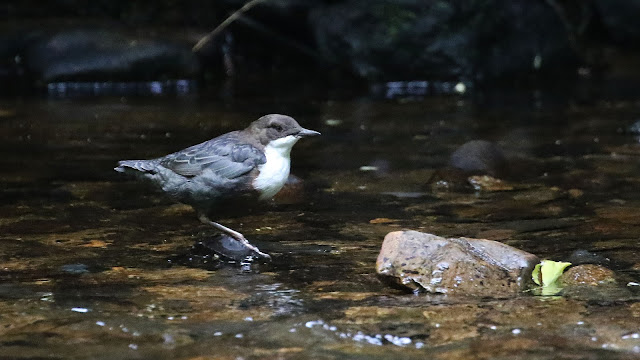At the start of the year we planned our main holiday for the year, this year it was to have been Madagascar, a wonderful itinerary would have seen us turning up at Heathrow this evening for a flight to Nairobi, to connect on Saturday to Antananarivo. In February the world changed and all those plans went up in smoke. We needed to get away and with the easing of lockdown found a cottage just outside Okehampton in Devon. We set off early to ensure we missed the traffic that was going to be heavy and the first stop was just outside Teignmouth, Labrador Bay, a site managed by the RSPB for one of the country's rarest breeding birds, the Cirl Bunting.
The Cirl Bunting is a small finch-like bird which is a close
relative of the yellowhammer. They were
once widespread and common across much of southern England, but in recent
years, they have become rare and only found in south Devon, mostly confined to
coastal farmland between Plymouth and Exeter.
The loss of food sources and nesting sites had caused this dramatic
decline.
During the winter, Cirl Buntings forage in weedy stubble
fields, feeding on seeds and spilt grain. In the summer, they nest in
hedges or scrub, and forage in unimproved grassland full of invertebrates -
grasshoppers are a particularly valuable food for chicks. As Cirl Buntings
are very sedentary (they only move up to 2 km between their breeding and
wintering areas), it is vital all these habitats are close to each other.
Changes in agriculture during the 20th century have made
farms more productive, but these changes have meant Cirl Buntings have
struggled to find food and nesting sites. Technological advances such as
autumn-sown cereals replacing spring-sown varieties, more efficient machinery
resulting in less spilt grain, increased fertiliser and pesticide use and hedge
removal to create larger fields have all had an impact.
A widespread trend towards specialised farms has seen farms
in the west of the country converting to mainly grass and farms in the east
growing arable crops. This has resulted in a reduction of mixed farms,
which makes life very difficult for a species like the cirl bunting which needs
both grass and arable habitats close to each other.
In Devon, small traditionally-managed coastal farms have
persisted, the exposed coastal environment making spring crops a more viable
option than winter cropping. This has made this area more appealing to Cirl Buntings.
In 2008 The RSPB brought land at Labrador Bay (the bay in the photo above) to make it the United Kingdoms's only Cirl Bunting reserve. This year according to the notice board 30 pairs have bred which is a good healthy number.
I haven't seen Cirl Bunting in the United Kingdom sine the early nineties, then it would be around the cliff tops at Wembury in south west Devon. I have seen them in France and Portugal but I wanted to catch up with an English bird. I was a little doubtful we would see them today, we are going into August and I wondered if they would be silent and hiding to moult. Having been driving for two and three quarter hours a cup of tea and a stretch of the legs was the priority. As we drank I heard the familiar song of the Cirl Bunting from the hedge around the car park. I could just see the bird but as I went to get the camera it was gone. A good start though.
After tea we walked onto the grassland behind the car park and walked along the track, as we passed a clump of hedge and one sang again. Walking back Helen found it at the top of the bush, my first English Cirl Bunting for probably 30 years!
You can see it must have been a busy breeding season, the plumage looks a little worse for wearThe head is thrown back in song just like the Corn Bunting and Yellowhammer
In spring, males have a striking black chin, eye stripe and
crown and yellow stripes on head and yellow underparts. Female and juveniles
look similar to yellowhammers, but have bolder head markings and streaked
grey/brown rumps.
 There was very little else about, Gatekeepers and Meadow Browns were abundant over the bramble bushes, so we decided to move on and attempt to find another south west specialty.
There was very little else about, Gatekeepers and Meadow Browns were abundant over the bramble bushes, so we decided to move on and attempt to find another south west specialty.It then flew down river as we walked up river and found yet another.
 A
characteristic activity of a perched dipper is a rapid series of bowing
movements, becoming more frequent and intense when birds are agitated or during
territorial disputes.
A
characteristic activity of a perched dipper is a rapid series of bowing
movements, becoming more frequent and intense when birds are agitated or during
territorial disputes. There was little else about but it was a lovely walk winding through the trees with the sound of the river running over rocks and rapids. In a quieter stretch of water in an area you would not expect to find a dipper we came across our forth of the walk, this time perched on a branch in the water and it was preening
Here you can see the white eye lid Dippers will blink rapidly, showing the white upper surface of the eyelid. They also have a third, transparent eyelid called a 'nictitating membrane' that they can close, enabling them to see underwater.
Then some gymnastic activities
On one leg!
and more wing flapping
Walking back we came across a Dipper in a location close to where we had seen one earlier so had to assume it was one of the four we had seen

































No comments:
Post a Comment